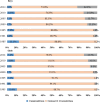Forced vital capacity and body mass index of Xinjiang children and adolescents: an analysis based on seven successive national surveys, 1985-2014
- PMID: 38849797
- PMCID: PMC11161940
- DOI: 10.1186/s12889-024-19072-x
Forced vital capacity and body mass index of Xinjiang children and adolescents: an analysis based on seven successive national surveys, 1985-2014
Abstract
Background: Pulmonary function is very important for the healthy development of children and adolescents. However, fewer studies have been conducted on pulmonary function trends in children and adolescents in remote areas. The aim of this study was to estimate the forced vital capacity (FVC) trend and its relationship with body mass index (BMI) among young people in Xinjiang during 1985-2014 using data from seven successive national surveys.
Methods: A total of 19,449 Xinjiang children and adolescents aged 7-18 years were extracted from the Chinese National Survey on Students' Constitution and Health. Height, weight, and FVC were measured repeatedly in each survey. FVC comparisons between adjacent surveys by age and sex were conducted by nonparametric Kruskal-Wallis after Kolmogorov-Smirnov of normality. One-way ANOVA and least significant difference(LSD) method was used to compare differences in FVC levels of Xinjiang children and adolescents with different BMI. The relationship between BMI and FVC was investigated using a nonlinear regression model.
Results: The FVC levels of Xinjiang children and adolescents peaked in 2000, with overall FVC levels being 8.7% higher in 2000 than in 1985. Since then, a substantial decline occurred, contrasting to 2000, with FVC levels decreasing by 27% in 2014, which was still lower than that in 1985 by 20.73%. The proportion of overnutrition boys increased from 0.2% in 1985 to 22.1% in 2014, and girls from 0.5% in 1985 to 14.5% in 2014. An inverted U-shape association between FVC and BMI values was obtained for Xinjiang children and adolescents.
Conclusions: Targeted measures should be carried out in schools to control BMI levels to ensure good lung function in children and adolescents in Xinjiang. Future studies should pay more attention to other factors affecting FVC, such as dietary behaviour, physical activity, and racial differences among children and adolescents.
Keywords: FVC; Inversed U-shape; Obesity; Xinjiang children and adolescents.
© 2024. The Author(s).
Conflict of interest statement
The authors declare no conflict of interest.
The authors declare no competing interests.
Figures





Similar articles
-
Compared with dietary behavior and physical activity risk, sedentary behavior risk is an important factor in overweight and obesity: evidence from a study of children and adolescents aged 13-18 years in Xinjiang, China.BMC Pediatr. 2022 Oct 7;22(1):582. doi: 10.1186/s12887-022-03646-y. BMC Pediatr. 2022. PMID: 36207679 Free PMC article.
-
Sex comparison of the association between weight-adjusted waist index and physical fitness index: a cross-sectional survey of adolescents in Xinjiang, China.Sci Rep. 2025 May 28;15(1):18723. doi: 10.1038/s41598-025-03131-3. Sci Rep. 2025. PMID: 40437112 Free PMC article.
-
Relationship between body mass index and physical fitness of children and adolescents in Xinjiang, China: a cross-sectional study.BMC Public Health. 2022 Sep 5;22(1):1680. doi: 10.1186/s12889-022-14089-6. BMC Public Health. 2022. PMID: 36064657 Free PMC article.
-
Trends in physical fitness, growth, and nutritional status of Chinese children and adolescents: a retrospective analysis of 1·5 million students from six successive national surveys between 1985 and 2014.Lancet Child Adolesc Health. 2019 Dec;3(12):871-880. doi: 10.1016/S2352-4642(19)30302-5. Epub 2019 Sep 30. Lancet Child Adolesc Health. 2019. PMID: 31582349
-
The sex-based disparity in BMI-for-age z-score trends among Xinjiang children and adolescents using four rounds of cross-sectional surveys from 1985 to 2014.J Public Health (Oxf). 2020 Nov 23;42(4):731-739. doi: 10.1093/pubmed/fdz189. J Public Health (Oxf). 2020. PMID: 32123896
Cited by
-
Associations between sugar-sweetened beverage consumption, weight-adjusted-waist index, with psychological symptoms: a cross-sectional survey of adolescents in mainland China.Front Psychiatry. 2025 Mar 28;16:1558919. doi: 10.3389/fpsyt.2025.1558919. eCollection 2025. Front Psychiatry. 2025. PMID: 40225846 Free PMC article.
References
-
- du Bois RM, Weycker D, Albera C, Bradford WZ, Costabel U, Kartashov A, King TJ, Lancaster L, Noble PW, Sahn SA, et al. Forced vital capacity in patients with idiopathic pulmonary fibrosis: test properties and minimal clinically important difference. AM J RESP CRIT CARE. 2011;184(12):1382–9. doi: 10.1164/rccm.201105-0840OC. - DOI - PubMed
-
- Nintedanib in children and adolescents with fibrosing interstitial lung diseases., Deterding R, Young LR, DeBoer EM, Warburton D, Cunningham S, Schwerk N, Flaherty KR, Brown KK, Dumistracel M, Erhardt E, Bertulis J, Gahlemann M. S. Stowasser and M. Griese for the InPedILD trial investigators. Eur Respir J 2023; 61: 2201512. EUR RESPIR J 2023, 61(5). - PMC - PubMed
-
- van Meel ER, Mensink-Bout SM, den Dekker HT, Ahluwalia TS, Annesi-Maesano I, Arshad SH, Baiz N, Barros H, von Berg A, Bisgaard H et al. Early-life respiratory tract infections and the risk of school-age lower lung function and asthma: a meta-analysis of 150 000 European children. Eur Respir J 2022, 60(4). - PMC - PubMed
Publication types
MeSH terms
Grants and funding
- (23YJC890002)/The Youth Fund Program for Humanities and Social Sciences Research of the Ministry of Education
- (23YJC890002)/The Youth Fund Program for Humanities and Social Sciences Research of the Ministry of Education
- (YQYB2023058)/General Project of Cultivating Excellent Young Teachers in Anhui Universities
- (82373595)/This study was supported by the National Natural Science Foundation of China
LinkOut - more resources
Full Text Sources

